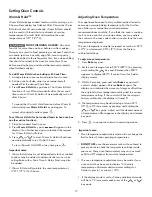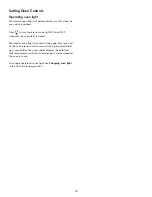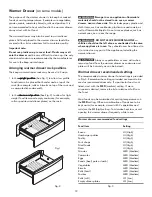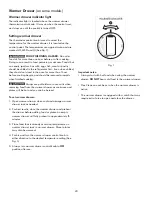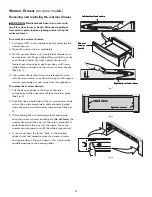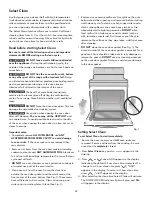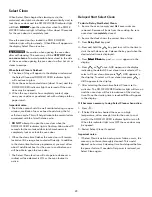
8
Before Setting Surface Controls
Please note:
The size and type of utensil used, and the
amount and type of food being cooked will influence the
burner flame setting needed for best cooking results.
Cookware material types
The most popular materials available are:
Aluminum -
Excellent heat conductor. Some types of food
will cause it to darken (Anodized aluminum cookware
resists staining & pitting).
Copper -
Excellent heat conductor but discolors easily.
Stainless -
Slow heat conductor with uneven cooking results.
Is durable, easy to clean and resists staining.
Cast Iron -
A slow heat conductor however will retain heat
very well. Cooks evenly once cooking temperature is
reached.
Porcelain-enamel on metal -
Heating characteristics will
vary depending on base material.
Glass -
Slow heat conductor.
Using proper cookware
For best cooking results,
cookware should have
flat bottoms that rest
level on the surface
burner grate. Before
using cookware, check
for flatness by rotating
a ruler across the
bottom of the cookware
(Fig. 1).
DO NOT place flammable items
such as
plastic salt and pepper shakers, spoon holders or plastic
wrappings on the cooktop when it is in use. These items
could melt or ignite. Potholders, towels or wooden spoons
could catch fire if placed too close to the range cooktop.
Important: DO NOT place aluminum foil, or ANY material
that can melt on the range cooktop.
If these items melt they
may damage the cooktop.
Fig. 1
Setting proper burner flame size
Never extend the flame beyond the outer
edge of the cooking utensil. A higher flame wastes energy,
and increases your risk of being burned by the flame.
The color of the flame is the key to proper burner adjustment.
A good flame is clear, blue and hardly visible in a well-lighted
room. Each cone of flame should be steady and sharp. Adjust
or clean burner if flame is yellow-orange.
Correct
flame setting
Incorrect
flame setting
For most cooking;
start on the highest setting and then turn
to a lower setting to complete the process. Use the
recommendations below as a guide for determining proper
flame size for various types of cooking (Fig. 2)
For deep fat frying;
use a thermometer and adjust the
surface knob accordingly. If the fat is too cool, the food
will absorb the fat and be greasy. If the fat is too hot, the
food will brown so quickly that the center will be under
cooked. Do not attempt to deep fat fry too much food at
once as the food will neither brown or cook properly.
*These settings are based for medium-weight metal or
aluminum pans with lids. Settings may vary when using
cookware made from different materials.
Fig. 2
Flame size*
Type of cooking
High flame
Start most foods; bring water to a boil;
pan broiling.
Medium flame
Maintain a slow boil; thicken sauces,
gravies; steaming.
Low flame
Keep foods cooking; poach; stewing.

















